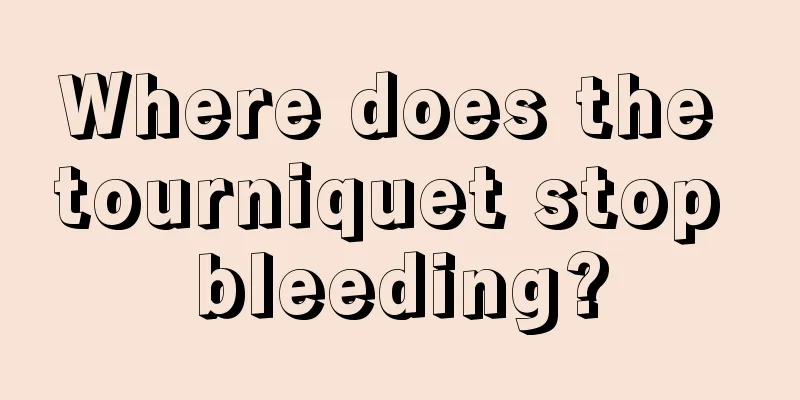Where does the tourniquet stop bleeding?

|
When people are bleeding for various reasons, they still need to use the tourniquet correctly to prevent the patients from being in danger of their lives. So where is the tourniquet to stop bleeding? If the tourniquet is used improperly, the consequences can be extremely serious, and may even lead to functional disorders or loss of life. Therefore, every detail needs to be treated with caution to stop the bleeding smoothly and avoid injury. There are only two areas where a tourniquet should be used: the forearm (just under the armpits) and upper thighs. Choose a cloth tape that is at least 5 cm (2 inches) wide to use as a tourniquet. If you are forced to use narrower lines (wires or ropes), you must pad them with multiple layers of folded cloth to reduce discomfort and avoid damage to nerves or muscles.To stop bleeding, wrap the tourniquet around the limb three times, tie it into a half knot, place a light short stick on the knot, and then tie it into a double knot. The tourniquet must be tightened until the bleeding stops. When stopping bleeding, the tourniquet must be tied tightly enough to stop the blood supply, but it must be loosened at intervals. The above-mentioned tying method can facilitate loosening. After the blood vessel is ligated, the tourniquet should be completely removed. After selecting the location of the tourniquet, you should first place a cloth strip there, tighten the tourniquet, wrap it around the limb twice and tie a knot. The tightness should be appropriate, and the wound should stop bleeding. Remember the time when putting on the tourniquet. Loosen it for 1/2 minute every half hour in winter and every hour in summer, and then tie it up again. When tying again, move the part slightly up and down. Patients with severe bleeding should be sent to the hospital for treatment as soon as possible while applying a tourniquet. If the artery is completely severed, the ends may atrophy and be difficult to find. Once you are sure the artery is in a small area of tissue, you can use a large needle to sew the entire area shut. While checking whether the operation was successful, loosen the hemostatic bandage as soon as possible to find out whether the artery causing the bleeding is the only one that has been bandaged. If bleeding is still found, the tourniquet should be re-applied immediately and the search for ruptured blood vessels should continue. There are other small blood vessels in the tissues that provide the limbs with the blood necessary to maintain physiological metabolism and maintain circulation. Through the above introduction, everyone is clear about where the tourniquet stops bleeding. When stopping bleeding, you must pay attention to the correct order and not be too hasty. After using the tourniquet, you must rush to the hospital as soon as possible and seek help from a doctor to take emergency measures, which can save the patient from danger. |
<<: What is the method of using a tourniquet to stop bleeding?
>>: What should I pay attention to after using a tourniquet to stop bleeding?
Recommend
How many days does it take to eliminate the inflammation of appendicitis abscess
Appendicitis is relatively common in clinical pra...
Can figs be kept in the refrigerator?
Figs are a food with relatively high nutritional ...
Is hypertensive heart disease very serious?
Hypertensive heart disease is of course a relativ...
What to do if skin allergy and peeling occur? These are the 3 ways to relieve it
Skin allergies and peeling are common skin proble...
Functional exercises of the temporomandibular joint of patients with nasopharyngeal carcinoma after radiotherapy
After radiotherapy, patients are likely to experi...
How to eat healthily to avoid liver cancer? Be careful of liver cancer if you eat this kind of food
Sashimi is especially popular among Japanese peop...
Pimples appear on the bridge of my nose where the glasses are
The bridge of the nose is a part of the body that...
What to do if the wound is red and swollen after surgery
Surgery is the most direct way to treat human dis...
Where does breast cancer usually hurt
Where does breast cancer usually hurt? 1. Except ...
Steaming rice cooker
A steaming rice cooker is actually the one we use...
Do you know the prevention knowledge of lymphoma?
Today we are going to study some knowledge about ...
What is the chance of recurrence of ovarian teratoma after surgery?
Ovarian teratomas are common in women of childbea...
Can applying potatoes on the face remove acne scars? Do you understand the principle?
Potatoes are a very common food in our daily life...
Only good measures can effectively prevent cervical cancer
At present, the number of cervical cancer patient...
Bone cancer can cause functional impairment in people in the later stages
Bone cancer can cause functional impairment in pe...









